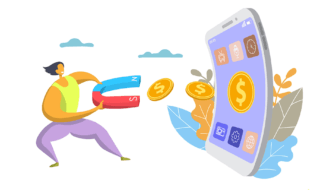Bitcoin is a new form of currency that was created in 2009 by an unknown person using the alias Satoshi Nakamoto. Transactions are made with no middlemen – meaning, no banks! Bitcoin can be used to book hotels on Expedia, shop for furniture on Overstock, and buy Xbox games. But much of the hype is about getting rich by trading it. The price of bitcoin skyrocketed into the thousands in 2017. You can also take help from Bitcoin Motion site, if you want to gain knowledge and strategies about bitcoin trading.
So what is bitcoin? Bitcoin is a digital asset and a payment system invented by Satoshi Nakamoto. Transactions are verified by network nodes through cryptography and recorded in a public dispersed ledger called a blockchain. Bitcoin is unique in that there are a finite number of them: 21 million.
Bitcoins are created as a reward for a process known as mining. They can be exchanged for other currencies, products, and services. As of February 2015, over 100,000 merchants and vendors accepted bitcoin as payment.
Bitcoin has been labelled a ‘virtual currency’, but this is somewhat misleading. Bitcoin is ‘virtual’ in the sense that it exists only in digital form. However, it is not a ‘currency’ because it does not have legal tender status in any jurisdiction.

The blockchain is a distributed database that maintains a continuously-growing list of records, called blocks. Each block contains a cryptographic hash of the previous block, a timestamp, and transaction data. Bitcoin nodes use the blockchain to differentiate legitimate Bitcoin transactions from attempts to re-spend coins that have already been spent elsewhere.
The blockchain is also used to enforce a cap on the total number of bitcoins that will ever be created. Nakamoto designed Bitcoin so that only 21 million bitcoins could ever be created, and the last one is expected to be mined in 2140. This makes bitcoin more akin to gold than a currency.
Bitcoins are created by a process called ‘mining’. Miners are rewarded with bitcoins for verifying and committing transactions to the blockchain. Bitcoin miners are processing transactions and securing the network using specialized hardware and software. They are rewarded with transaction fees and newly created bitcoins. As of February 2015, over 100,000 merchants and vendors accepted bitcoin as payment.
Bitcoin is a digital asset and a payment system invented by Satoshi Nakamoto. Transactions are verified by network nodes through cryptography and recorded in a public dispersed ledger called a blockchain. Bitcoin is unique in that there are a finite number of them: 21 million.
Benefits of Bitcoin Blockchain
Bitcoin blockchain technology has attracted huge attention from the business and technology communities due to its potential benefits, which include:
- Increased transparency and security. The distributed ledger technology underlying the bitcoin blockchain can create a more transparent and secure financial system. For example, it could help reduce fraudulent activities such as money laundering.
- Reduced costs and faster transactions. The bitcoin blockchain can help businesses reduce transaction costs and processing times. For instance, by eliminating the need for third-party verification, the bitcoin blockchain could help speed up cross-border payments.
- Increased efficiency and innovation. Bitcoin blockchain could increase efficiency and spur innovation in a number of industries, including finance, healthcare, and supply chain management. For instance, it could enable new types of peer-to-peer transactions that would not be possible with traditional financial systems.
Despite its potential benefits, there are some concerns about the bitcoin blockchain. For example, its openness and anonymous nature could lead to criminal activities. Additionally, the large amount of energy required to power the bitcoin blockchain could have negative environmental consequences. Nevertheless, the potential benefits of bitcoin blockchain technology appear to outweigh these concerns, and it is likely to play a key role in the future of business and technology.
Conclusion
The blockchain is a growing list of records, called blocks, which are linked using cryptography. Each block contains a cryptographic hash of the previous block, a timestamp, and transaction data. Bitcoin nodes use the blockchain to differentiate legitimate Bitcoin transactions from attempts to re-spend coins that have already been spent elsewhere.
The blockchain is managed by a decentralized network of nodes running bitcoin software. Transactions are broadcast to the network using software applications. Nodes that do not agree with the majority of other nodes will be automatically kicked off the network. Bitcoin Core is the reference client for the bitcoin network. It is open-source and free to use.
Bitcoin miners are rewarded with transaction fees and newly created bitcoins. As of February 2015, the reward was 12.5 bitcoins per block mined. This decreases every 210,000 blocks until it reaches zero, which is estimated to happen in 2140. The rewards will then be solely from transaction fees.



